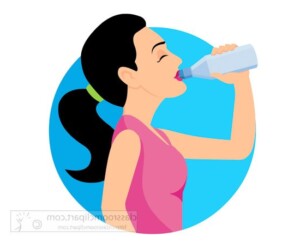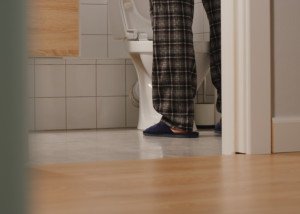
You aren’t imagining it: There may very well be a link between perimenopause and more frequent urinating than usual, including those overnight trips to the bathroom.
How many voids per 24 hours define urinary frequency?
“Although there is no absolute number of daytime voids that is ‘abnormal,’ urinary frequency is typically defined as more than eight voids/24 hours,” says R. Mark Ellerkmann, MD, Director, The Urogynecology Center at Mercy Medical Center, Baltimore.
“However, many things can influence the degree of urinary frequency — how much one drinks, what one drinks, whether someone is on a diuretic, etc.”
So right off the bat, you may want to ask yourself if perimenopause has been making you consume more fluids, though thirst is not a symptom of perimenopause.

Overactive Bladder
Dr. Ellerkmann says that usually, complaints of urinary frequency come with additional symptoms:
• Urinary urgency (“sudden, compelling desire to pass urine which is difficult to defer”)
• Nocturia – getting up in the middle of the night to relieve oneself more than once
• Urge related
“The constellation of these symptoms provide for a clinical diagnosis we refer to as overactive bladder or OAB (defined as urgency, often with frequency and nocturia, with or without urge related urinary incontinence),” explains Dr. Ellerkmann.
Severity does increase with age, but perimenopause typically occurs in a woman’s 40s. Urge related incontinence is more common in women.
“Urge incontinence increases with age, from 17 percent of women older than 45 years to 27 percent of women older than 75 years of age.”
The Perimenopause and Urinary Frequency Connection
“Perimenopause is defined at that period of time leading up to menopause,” says Dr. Ellerkmann.
“Many physiological changes occur during the perimenopausal time period as levels of circulating hormones — estrogen, progesterone and testosterone — fluctuate and levels slowly decrease.
“The effects of estrogen on the urogenital tract are well-known, as these tissues (the vaginal and peri-urethral tissues/bladder) are very rich in estrogen receptors.
“As circulating estrogen levels decrease and become less consistent, vaginal and peri-urethral tissues become less well-lubricated; they become thinner and less elastic and less well-vascularized [stocked with blood vessels].
“It may be that the loss of estrogen can adversely affect the bladder, but whether the hormonal changes of perimenopause are directly related to symptoms of urinary frequency is difficult to say.”
Solutions to Increased Urinary Frequency from Perimenopause
Dr. Ellerkmann says that some studies support the use of supplemental vaginal estrogen cream in both periomenopausal and menopausal women to partially alleviate symptoms of overactive bladder.
Dr. Ellerkmann also explains, “Excluding organic causes that might cause overactive bladder symptoms (bladder cancers, stones, bladder prolapse, infections, foreign suture or mesh from urological surgery) or medications (diuretics) or behavior (excessive consumption of liquids), the most common inciting causes of urinary frequency and urgency are consumption of known dietary irritants — the most common of which are caffeinated beverages, tea, artificial sweeteners, carbonated beverages, citrus juices, tomatoes, chocolate, sodas.”
Dr. Ellerkmann is board certified in both OB/GYN and female pelvic medicine and reconstructive surgery. He specializes in the treatment of urinary incontinence in women of all ages.
is board certified in both OB/GYN and female pelvic medicine and reconstructive surgery. He specializes in the treatment of urinary incontinence in women of all ages.
 Lorra Garrick has been covering medical, fitness and cybersecurity topics for many years, having written thousands of articles for print magazines and websites, including as a ghostwriter. She’s also a former ACE-certified personal trainer.
Lorra Garrick has been covering medical, fitness and cybersecurity topics for many years, having written thousands of articles for print magazines and websites, including as a ghostwriter. She’s also a former ACE-certified personal trainer.
.









































